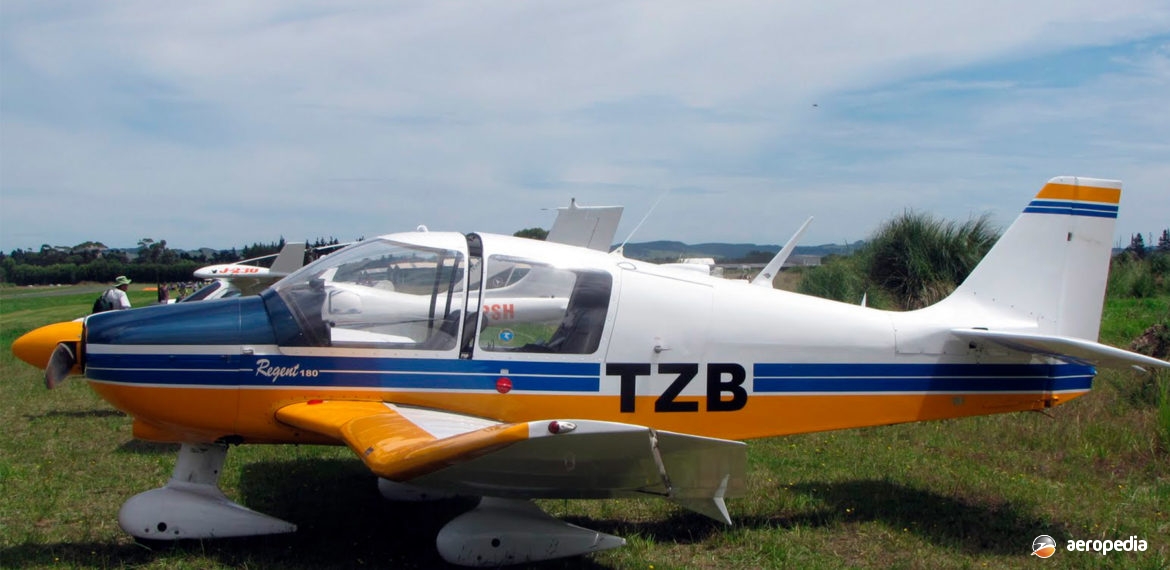Photograph:
New Zealand registered DR400-180 Regent ZK-TZB (c/n 1043) (NZCIVAIR)
Country of origin:
France
Description:
Four-seat light touring monoplane
Power Plant:
(DR400-180 Regent)
One 149 kw (200 hp) Textron Lycoming IO-360 A3A four-cylinder horizontally-opposed air-cooled engine
Specifications:
- Wingspan: 8.74 m (28 ft 7½ in)
- Length: 7.10 m (23 ft 3½ in)
- Height: 2.23 (7 ft 4 in)
- Wing area: 14.20 m² (152.86 sq ft)
- Never exceed speed: 307 km/h (191 mph)
- Max speed at sea level: 278 km/h (173 mph)
- Cruising speed at 75% power at 2,591 m (8,500 ft): 254 km/h (158 mph)
- Cruising speed at 65% power at 2,591 m (8,500ft): 241 km/h (150 mph)
- Stalling speed clean: 106 km/h (66 mph)
- Stalling speed in landing configuration: 94 km/h (59 mph)
- Service ceiling: 4,724 m (15,500 ft)
- Take-off ground roll: 315 m (1,034 ft)
- Take-off over 15 m (50 ft) obstacle: 610 m (2,001 ft)
- Rate of climb at sea level: 252 m (826 ft/min)
- Landing distance of 15 m (50 ft) obstacle: 530 m (1,739 ft)
- Landing ground roll: 250 m (820 ft)
- Empty weight: 600 kg (1,323 lb)
- Useful load: 500 kg (1,102 lb)
- Loaded weight: 1,100 kg (2,425 lb)
History:
Following the success of the DR253 Regent, DR315 Cadet, DR340 Major, DR360 Chevalier and DR380 Prince series of aircraft, all of which were basically of wooden construction, Centre Est, or Robin, introduced the DR400, construction of the prototype of which began in 1971. The first of this new series was the DR400-125 Petit Prince powered by a 93 kw (125 hp) Avco Lycoming O-235-F2B engine, this being a three/four-seater and received its Type Certificate in December 1972. It was followed by the DR400-180 Regent, with the 134 kw (180 hp) Avco Lycoming O-360-A engine, which replaced the DR253 and DR380 series in production.
Further models were later introduced, including the DR400-140 Major with a 104 kw (140 hp) Avco Lycoming O-320-E engine; and DR400-180R Remorquer, with the 134 kw (180 hp) engine, which was for glider towing; and the DR400-2+2 with a 75 kw (100 hp) Avco Lycoming O-235-C20 engine, this being a two-seat model with provision for the accommodation of two small children.
In 1980 the DR400-120 Dauphin 80 replaced the latter, being fitted with an 84 kw (112 hp) Avco Lycoming O-235-L2A engine. This series was known for its good looks, excellent aerodynamics, high performance, good visibility, superior comfort and pleasant handling in the best European tradition. Development led to the DR500 President series, this being a four / five-seat enlarged variant of the DR400 with increased power, being fitted with the Textron Lycoming 149 kw (200 hp) fuel-injected IO-360 engine driving a Hartzell constant-speed propeller. Standard fuel was contained in two 40 litre (8.8 Imp gal) fuel tanks in the leading-edge of the wing, a main tank containing 105 litres (23 Imp gals), and an auxiliary tank containing 90 litres (20 Imp gals).
An example of the DR400 series is being built in Sydney by an amateur builder using plans supplied by the French company and it is expected to be registered under Experimental Rules when completed. The New Zealand importer of the series, Izard Pacific Aviation, imported a DR400-180 Regent, this aircraft becoming ZK-TZB (c/n 1043 – ex F-ODAN) in January 2004. This model seated four and had a baggage allowance of 60 kg (132 lb) behind the rear seats, accessed by a separate hatch on the port side. In this model the fuel was carried in four fuel tanks, comprising two wing-root tanks, a central fuselage tank and an auxiliary tank. The DR400 and DR500 are of wood construction with fabric covering, non-structural parts being of fibreglass, the airframe being hand built. More than 3,000 examples of the DR400 series has been completed.

